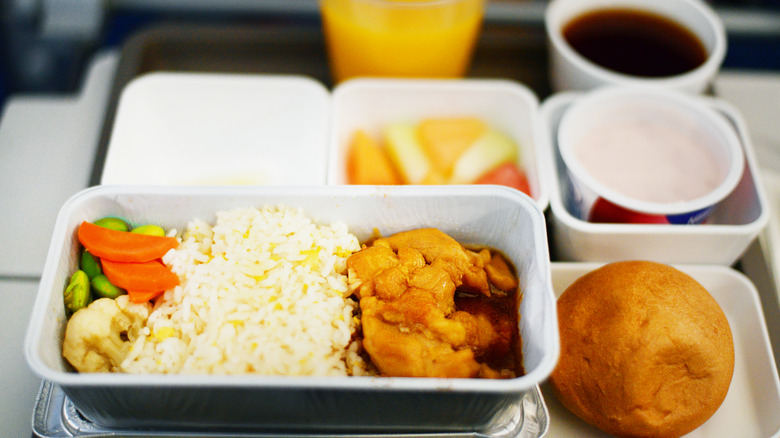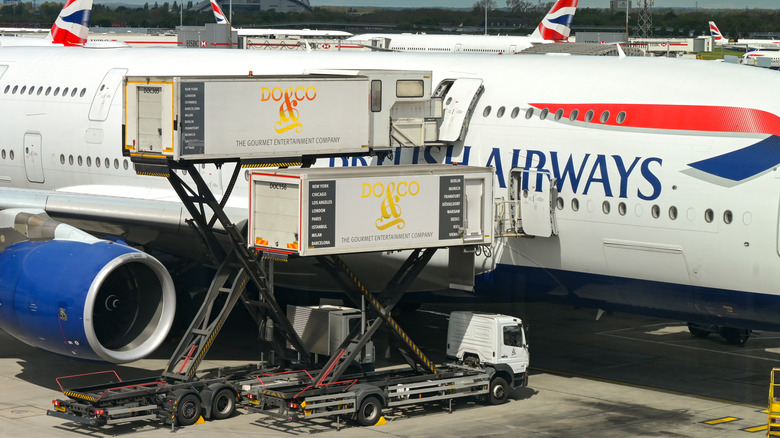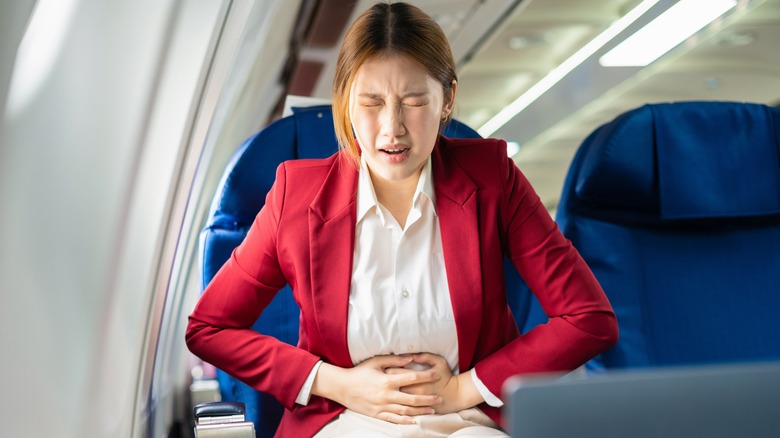How Airlines Stop Your In-Flight Meals From Causing Foodborne Illnesses
For many travelers, foodborne illness and using cramped airplane bathrooms are two of the worst parts of traveling. Scaling it to hundreds of travelers needing a handful of bathrooms at one time on a flight would make the trip into a true horror story. Take 1992's Aerolineas Argentinas Flight 386, when shrimp caused an onboard cholera outbreak, or the infamous 1975 Japan Airlines flight where a cook gave nearly 200 passengers food poisoning. These two incidents taught airlines and their catering partners how to keep passengers and crew safe and prevent cascading financial, operational, and reputational costs. And, it's the reason many airlines don't allow pilots to eat the same meal.
Food on board has come a long way since United opened its first flight kitchen in 1936. Today, Delta, American, Emirates, and Singapore Airlines (just to name a few) have invested millions into their catering operations to meet passengers' demands, namely healthier and more culturally sensitive options, and to appease local regulators. Keeping flyers safe starts with stringent regulations on the ground. In the U.S., the Food Safety Modernization Act (FSMA) requires airlines and caterers to register with the FDA and involves frequent inspections of kitchens, traceable supply chains, and limited exposure to common allergens. The U.S. isn't alone though; the European Union and India have strict regulatory penalties for airlines that cannot ensure food safety onboard.
Even after food has been prepared in a sterile environment, there are still risks of getting sick. However, the risks from the meal itself are generally the same as going out to a restaurant. Another potential cause of foodborne illness, though, could come from a flight attendant improperly washing their hands after coming into contact with a high touch point and passing germs through the cabin during meal service.
What to eat onboard
Airlines serve over a billion meals globally each year and are pushing to meet customers' demands for higher quality food and greater varieties of meals. With this growth comes tremendous revenue, (the airline catering industry is expected to hit over $21.5 billion in 2024), as well as more global airlines sourcing local ingredients. Regardless of whether the kitchen is owned by the airline, or contracted out to companies such as LSG Sky Chefs or Gate Gourmet, much of the food preparation process is the same. In short, the entire meal is cooked then flash frozen to minimize spoilage. The food is loaded onto a truck, placed on the aircraft, and finally reheated by the flight attendants before being delivered to your tray table.
In general, eating undercooked chicken, seafood, and rice are three common causes of food poisoning. Be careful with airline meals using these ingredients, especially if the food smells or looks strange. Also, note that due to differences in taste at 30,000 feet, airlines will commonly add heavy amounts of spices and salt to add flavor.
Moreover, uncooked vegetables and salads can also be unappetizing and may carry bacteria from being transported or stored improperly. Ice and the airplane's water tank can also be a source of bacteria, however, the risk of exposure will also depend on how well the aircraft is maintained and the crew's hygiene.
If you are nervous about the food, vegetarian meals, such as pasta and vegetable curries are normally safer as they've been fully cooked. As are packaged and dry foods, such as bread rolls, pretzels, and snack mixes. The safest bet is always to bring your own prepackaged foods, such as nuts, trail mix, and something that will not spoil. If you have any doubts, speak to a flight attendant.
What to do if you get sick
Having spent hours on international flights in the lav suffering from bad food (but never from an inflight meal ... knock on wood!), I'll be the first to tell you that having an angry stomach on a plane is the least bit of fun. If you start to feel ill, tell a flight attendant right away and let them know you're not doing well. They can bring you some water, a ginger ale, or a cup of tea to soothe your stomach, and will look out for you throughout the flight.
According to an article in the American Family Physician Journal, food poisoning is not a common emergency in-flight. However, should the worst happen, flight attendants on U.S. airlines are trained for your safety, and every aircraft is required by the FAA to have essential medical equipment on board. However, it's still a good idea to bring a small, well-stocked first aid kit with you. Common over-the-counter medicines such as Immodium and Pepto-Bismol work to limit food poisoning symptoms once you're sick, however, Travelan is one stomach medicine you can't forget if you're worried about food poisoning. You can take it before eating to limit the effects of a risky meal. For natural remedies, other travel experts swear by activated charcoal and apple cider vinegar capsules to stabilize your body after an exhausting episode of food poisoning.
Finally, the key is to stay hydrated. Hydration is critical to keeping your strength and limiting the long-term effects foodborne illness will have on your body. I always keep electrolyte packets in my bag in case my stomach decides to kick out an unwelcome visitor. And no matter if you're flying or in an airport, this simple tip will help you to avoid food poisoning while traveling.


